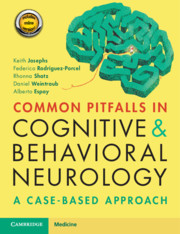Book contents
- Common Pitfalls in Cognitive and Behavioral Neurology
- Common Pitfalls in Cognitive and Behavioral Neurology
- Copyright page
- Dedication
- Contents
- Diseases Discussed in the Book
- Preface
- Acknowledgements
- Abbreviations
- Part 1 Missing the Diagnosis Altogether
- Part 2 Misidentifying the Impaired Cognitive Domain
- Part 3 Missing Important Clues in the History
- Part 4 Failure of Pattern Recognition
- Case 16 Too Many Behavioral Problems for Alzheimer Disease?
- Case 17 Look below the Surface (EEG)
- Case 18 “Too Young to Be Here”
- Case 19 Fluctuating Anxiety
- Case 20 Not Recognizing the Impostor
- Part 5 Difficult-to-Characterize Cognitive/Behavioral Disorders
- Part 6 Clinical Findings That Are Subtle
- Part 7 Misinterpreting Test Results
- Part 8 Attributing Findings to a Known or Suspected Disorder
- Part 9 Missing Radiographic Clues
- Part 10 Management Misadventures
- Index
- Plate Section (PDF Only)
- References
Case 17 - Look below the Surface (EEG)
from Part 4 - Failure of Pattern Recognition
Published online by Cambridge University Press: 03 November 2020
- Common Pitfalls in Cognitive and Behavioral Neurology
- Common Pitfalls in Cognitive and Behavioral Neurology
- Copyright page
- Dedication
- Contents
- Diseases Discussed in the Book
- Preface
- Acknowledgements
- Abbreviations
- Part 1 Missing the Diagnosis Altogether
- Part 2 Misidentifying the Impaired Cognitive Domain
- Part 3 Missing Important Clues in the History
- Part 4 Failure of Pattern Recognition
- Case 16 Too Many Behavioral Problems for Alzheimer Disease?
- Case 17 Look below the Surface (EEG)
- Case 18 “Too Young to Be Here”
- Case 19 Fluctuating Anxiety
- Case 20 Not Recognizing the Impostor
- Part 5 Difficult-to-Characterize Cognitive/Behavioral Disorders
- Part 6 Clinical Findings That Are Subtle
- Part 7 Misinterpreting Test Results
- Part 8 Attributing Findings to a Known or Suspected Disorder
- Part 9 Missing Radiographic Clues
- Part 10 Management Misadventures
- Index
- Plate Section (PDF Only)
- References
Summary
This 57-year old man was brought to the emergency department with a six-month history of episodic jaw pulling and arm flexion and subsequent progressive cognitive decline over this period. Initially rare, the episodes became more frequent. At the time of the hospital admission, he had one nearly every 20–30 minutes. Episodes were brief (three to five seconds) and most often unilateral but could affect either side. He was transiently disoriented with each episode, increasingly even up to a minute after motor signs’ termination. Phenytoin, valproate, and clonazepam used during the six-month period prior to admission did not provide any benefit. Initially, he was unimpaired between episodes, but about three months prior to his admission, he was noted to exhibit uncharacteristic slowed thinking and disorganization. He manifested difficulties recalling recent events and repeating stories or questions. He became depressed, withdrawn, and easily irritated. At his initial examination in the hospital, he was observed to have multiple stereotypical episodes (Video 17.1).
- Type
- Chapter
- Information
- Common Pitfalls in Cognitive and Behavioral NeurologyA Case-Based Approach, pp. 52 - 56Publisher: Cambridge University PressPrint publication year: 2020



